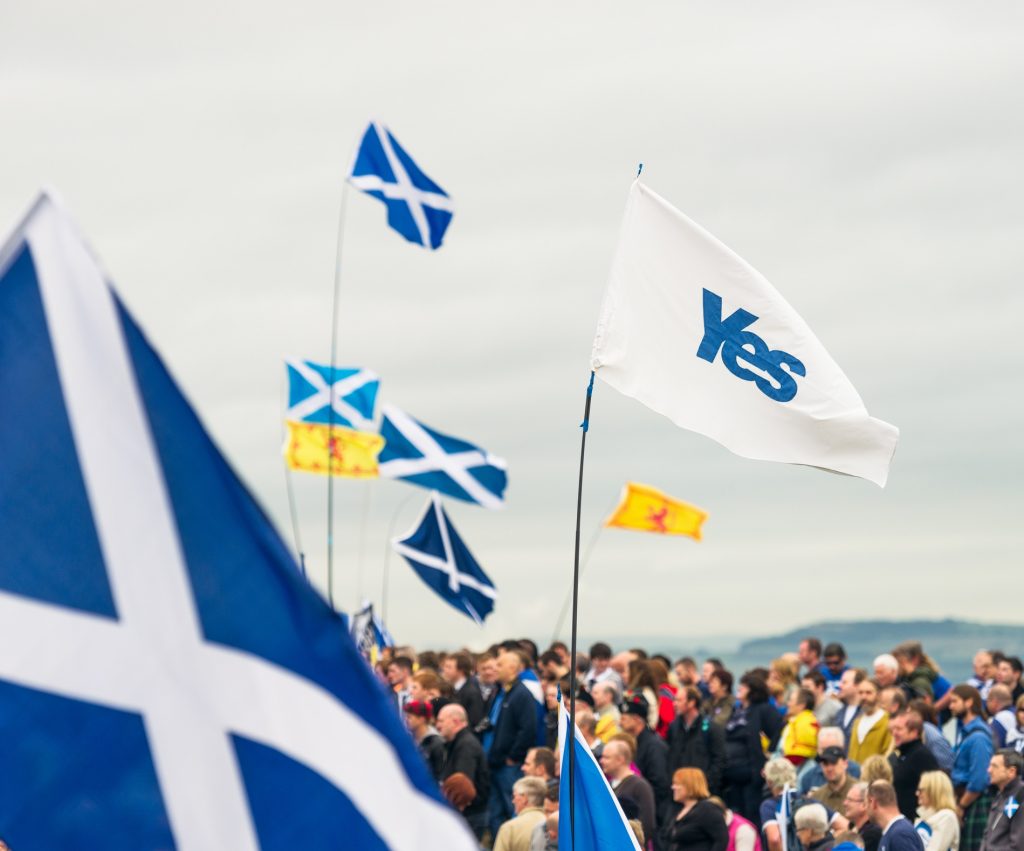Tom Montgomery, Lecturer in Work and Organisations, University of Stirling,
James Foley, Lecturer in Politics, Glasgow Caledonian University.
Ewan Kerr, Postdoctoral Researcher, Glasgow Caledonian University.

The independence movement in Scotland is going nowhere.
There are at least two different ways to read that sentence.
Firstly, that the recent crisis within the SNP has rendered independence a busted flush.
Or secondly, that independence, as a mobilising idea, is now so embedded in our politics that it will top the agenda until it happens.
These polarised lenses through which Scotland’s politics is perceived are almost part of the dress code for debating any issue. Of course, disagreement in politics is not new. But the crisis within the SNP, a material change in Scotland’s political landscape, owes its legacy to a much earlier history that can be traced back to the events of 2014.
Next September will mark a decade – yes, a decade – since the independence referendum.
The political theorist Erik Swyngedouw once opined that ‘every revolution has its square’ from Syntagma in Greece to Tahrir in Egypt. Perhaps George Square doesn’t rank as highly on the global political scene: the tectonic plates of political life in Scotland did not shift with the same magnitude as elsewhere. But the ground did shake all the same.
Anyone in Scotland during 2014 will have witnessed those tremors: debates on currency, oil revenues, pensions, austerity and much more momentarily changed venues – away from parliamentary chambers to community centres, church halls, workplaces, cafes, bars, restaurants, and even the local high street.
Regardless of whether you voted Yes or No – or even if you never voted – there is no disputing the impact of the referendum on Scotland and its politics.
To a great extent, the aftershock of those debates surrounding Scotland’s future continue to shape the current terrain. That’s why, to begin the process of understanding Scotland’s politics almost a decade later, we need to fully comprehend the impact of those events. Arguably, politics in Scotland have been stuck in that moment, and never really moved on from 18th September 2014.
That’s why understanding the Yes campaign of 2014 and the role of the SNP in that campaign is central to the task of understanding Scotland’s politics today, which is defined by a renewed sense of uncertainty about the future.
Part of that uncertainty relates to the current crisis in the SNP.
The phenomenal rise of the SNP as an election winning machine has been as dramatic as its recent reversal of fortunes. It is sometimes difficult to convey to those outside Scotland how the scandal, police investigations and resignations which have generated such publicity have necessitated a rethink amongst many about the trajectory of politics in Scotland.
The SNP is a party that, until very recently, many believed was the successor to what Gerry Hassan once described as ‘Labour Scotland’. This was a party which, in the analysis of many of Scotland’s opinion formers, would govern for decades to come. Where a candidate wearing a yellow and black rosette would be almost guaranteed success at the ballot box.
A party with this much power could shape not only the political agenda but the direction of public life in Scotland, just as the Labour Party had done so before.
Where did this power come from? That question can only be answered by examining the Yes campaign of 2014. The root of the extraordinary success of the SNP is that wave of politicisation that occurred in Scotland at that time.
The banners, badges and hopes invested in the Yes movement did not disappear on the 19th September 2014.
Instead, many who had cast their Yes vote decided instead to direct their disappointment with that result into voting for pro-independence parties, predominantly the SNP. Tens of thousands across Scotland even joined the SNP, transforming the party from a relatively small organisation with many members on a first-name basis into a mass membership party, almost overnight.
Many of those who joined the party at that time will have agreed with Alex Salmond, whose resignation speech in 2014 declared that ‘the dream will never die’. They then looked to Nicola Sturgeon – a gifted communicator and political operator – as the person who would realise that dream with a renewed and reinvigorated campaign.
The sense of an imminent return to what many of those who voted for independence regarded as the effervescence of the Yes campaign is a crucial, and often misunderstood, factor in the success of the SNP.
That moment of politicisation in 2014 has been a core muscle memory for mobilising the membership of the SNP and its supporters on an almost annual promise of a second referendum.
However, constitutional deadlock since 2014 has also contributed towards the de-politicisation of many of the policy challenges facing the SNP in government, disguising a failure to deliver on its progressive agenda.
This is why the current difficulties facing the SNP overshadow what has been a skilful highwire act of walking the tightrope between being a party of government in Britain and a party of insurgency which exists to dismantle the British state.
This was of course aided in recent years by the almost permanent state of emergency in Westminster following the Brexit referendum, the COVID-19 pandemic and, more recently, the cost-of-living crisis.
Now the SNP faces a reckoning with this legacy. Approaching the tenth anniversary of the referendum, it remains to be seen how, or even if, the SNP can resolve this crisis of its own making.
Should it translate into defeat at the ballot box, it will be another seismic change for Scotland’s politics.
For the independence movement, that has until now been inextricably linked to the SNP, this is a defining moment.
This blog post first appeared as am article in Holyrood Magazine in October 2023. The article draws on findings in the research paper: The Antinomies of Insurgency: The Case of the Scottish National Party.
